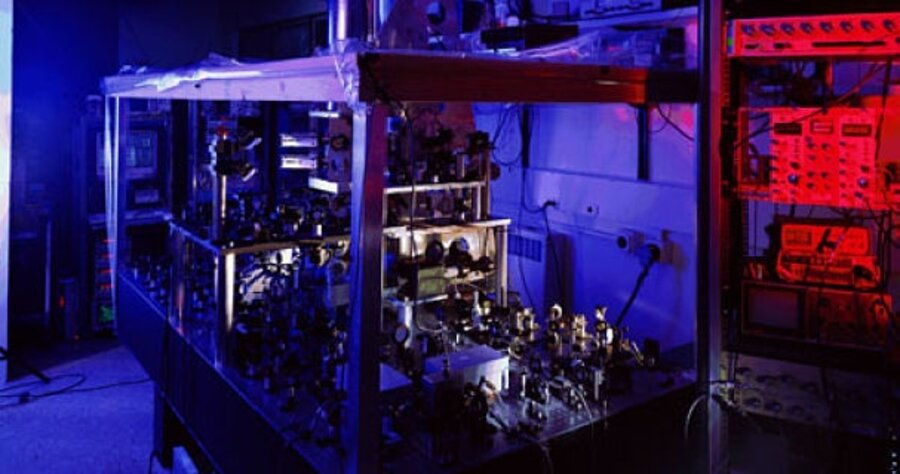Enjoy your leap second
Loading...
So you'd like a little more free time to kick back during this this holiday season? Enjoy New Year's Eve's leap second. On Dec. 31, at 11:59:59 p.m. Universal Time (6:59:59 p.m. Eastern time), atomic clocks around the world will add one second to the day.
The planned hiccup among the high-tech ticks and tocks comes courtesy of Earth's rotation rate, which is ever so slowly winding down. By some estimates, in 2100 a day will be 2 milliseconds longer than today's day. The leap second the world's timekeepers will add tomorrow will bring the world's high-tech atomic clocks back into sync with time as defined by Earth's rotation.
The idea of a time period that "leaps" at the end of a year dates back to the ancient Egyptians. Back then, it was a leap day added every four years. The Romans picked up on the idea as they adopted the Julian calendar. Later, the Gregorian calendar modified the rule: A leap day is added to any year whose number is evenly divisible by 4, unless the year is evenly divisible by 100. Then it isn't a leap year, unless it's also evenly divisible by 400.
Who needs a leap second anyway?
But the need for a leap second is relatively new. Scientists developed the first atomic clock in 1949. They found themselves using time pieces of beyond-exquisite precision. Today's versions might gain or lose one second after 60 million years. These clocks became the standard for timekeeping, defining the length of one second.
With timing that precise, however, scientists found that Earth's rotation rate varies and is slowing. The moon is the single largest influence on Earth's spin. But other factors can affect the twirl as well -- the bulge in the ocean as the moon's gravity tugs on it, or the amount of ice and snow at the poles. If Earth's rotation rate varies, defined by radiotelescope measurements of distant quasars, so would one second.
So where a leap year periodically makes up for the difference between a year on the calendar (365 days) and a year's trip around the sun (365 days plus 6 hours), the leap second makes up the difference between an atomic clock's second and one second as defined by astronomical time keeping.
In 1972, by international agreement, the world's timekeepers agreed to add a second to the end of a year whenever it was needed. Since then, they've added a leap second 23 times. The most recent leap second popped up Dec. 31, 2005.
Atomic clocks big and small
As for the atomic clocks themselves, they are undergoing changes at both ends of the size scale. During a phone chat, John Kitching describes work he and his colleagues are doing to shrink atomic clocks to the size of a sugar cube or grain of rice. Dr. Kitching is a physicist at the National Institute of Standards and Technology in Boulder, Colo.
Clocks typically used for national timekeeping fill a room. At the US Naval Observatory in Washington, its newest atomic clock is getting a climate-controlled room of its own for the first time, rather than getting squeezed into nooks and crannies in existing office space like past atomic clocks.
Geoff Chester, a spokesman for the observatory, says the hardware that forms the core of the new clock tips the scale at some 800 pounds; one component looks like a six-foot water heater.
That works for a full-time timing service whose job is to serve as the nation's timekeeper. But for a range of practical applications -- from better GPS navigation systems for cars or aircraft, to more-jam-resistant navigation gear for the military -- smaller is better.
The current generation of portable atomic clocks is roughly the size of a pack of playing cards. But it needs a car battery to run them, NIST's Kitching says. His team's goal: mini atomic clocks in sizes ranging from sugar cubes to rice grains that can operate on AA batteries.
With mini atomic clocks in hand-held or dashboard GPS navigation devices, the receivers would pick up signals from GPS satellites faster. They would require fewer satellites in view to get a good reading on your position -- a feature handy while driving among tall buildings in cities. And, he says, they would provide more-accurate beads on altitude, important for aircraft navigation. And for military uses, tiny clocks inside navigation gear would make jamming weak GPS satellite signals more difficult.
Such devices also could improve the reliability of cell phones, whose signals must be carefully timed as they travel from phone to tower, to control hub and back.
Protoypes are accurate to within 10 microseconds per day, or roughly 1 second per 274 years. Take that, Rolex!
Currently atomic clocks use the effect of microwaves on electrically charged atoms, or ions, to take the measure of one second. NIST researchers are working on a system that replaces microwaves with light in a new generation of atomic clocks. A prototype at NIST already has shown a stability that calculates into running neither a second too fast or a second too slow for at least 400 million years.





